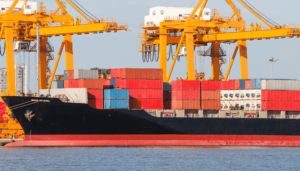By Hari Menon
Developed economies and rapid industrialization has led to the exponential growth of the cargo transport industry. 85% of international trade is done using ocean freight with a very vast majority of these cargo being transported in shipping containers.

Container vessels that can accommodate several thousand TEU on board, help move large quantities of cargo from one point to another.
The largest of such vessels can accommodate about 23000 TEU! Statistics of the World Bank show that close to 800 million TEU containers were shipped globally in 2019.
The COVID-19 pandemic had a negative impact on world trade and the movement of goods. However, the discovery of vaccines in 2021 to combat the pandemic is seen as the silver lining and the world’s economy is expected to bounce back.
Origin of the Modern Intermodal Container
Before the shipping container came into the scene, the cargo was usually loaded inside boxes of different sizes for handloading onto trucks and ships.
Malcolm Maclean, an American transport entrepreneur developed the first container made of corrugated steel in 1955 that could be easily transported on a truck or ship. He later sold the idea of his invention to the United States military which used these boxes to transport military equipment.
The two decades following the invention saw containers of different sizes and locking mechanisms that posed problems when it came to loading on different trucks and ships. In the following years, these problems were gradually sorted out.
The first standard container vessel launched in 1968 was Hakone Maru, a Japanese registered ship. This ship sailed between Japan and the west coast of the US. It catered to the transport of TEU containers and it could transport 752 twenty-foot equivalent unit containers.
Along with the different modes of transport that cater to the industry, the equipment used for transporting goods, and the technology used have also evolved. Modern cranes and cargo handling equipment are just two examples.
Types of Containers
Different types of cargo are transported over land, sea, and air. It is generally categorized as dry, chill, or frozen. Cargo could be temperature-sensitive, for example, food products, meat, pharmaceutical drugs, etc.
Such temperature-sensitive cargos have to be transported in containers that can maintain the temperature or humidity requirements of the cargo.
There could be other special transportation requirements too. Containers of different types and sizes are used to transport the different types of cargo based on the customer’s requirements. It is estimated that currently there are between 20 and 23 million TEU in circulation globally!
Containers are generally of two categories – dry containers and refrigerated containers.
Usually, dry containers are bare containers with lockable doors at one end though, containers with doors on either end are also found.
Refrigerated containers also known as reefers are used to transport goods that require special temperature settings so that they do not deteriorate or get damaged during transit and storage. The internal temperature of a reefer is controlled according to specifications.
Flat racks and open-top containers are used for the transport of Out of Gauge cargo (OOG). These are cargo that comes in abnormal sizes and shapes that do not fit inside a conventional shipping container such as a twenty-foot or a forty-foot container.
Examples for OOG cargo are wind turbine blades, very large industrial boilers, bulldozers, etc. Flat racks and open-top containers are also available in sizes of twenty-foot and forty-foot.
Container Size
Shipping containers come in two standard sizes, namely, twenty-foot and forty-foot containers. In shipping terms, these two are referred to as a TEU (Twenty-foot Equivalent Units) and an FEU (Forty-foot Equivalent Units) respectively. A standard TEU or FEU also goes by the name of a general-purpose container (20’ or 40’ GP container).
Though containers of varying sizes are used globally for the transportation of goods, the TEU and FEU are the most common. Some other sizes that shipping containers come in are forty-foot High Cube (40’ HC), forty-five-foot High Cube (45’ HC), etc.
The high cube containers have a height of one foot more than the normal GP containers. It is interesting to note here that in the world container market, there are more general-purpose containers than high cube ones, just as there are more of FEUs in circulation than TEUs!
Typically, a TEU is made of tough, heavy-duty, weather and corrosion-resistant steel, known as Corten steel. The components of such a container are the front-end wall panels, a roof, two sidewall panels, the floor, and a door frame with the door assembly and locking mechanism. One of the sidewall panels usually has a small opening for ventilation.
Containers are locked using lock-rods that run vertically on the two doors. Each door usually has two lock-rods on it. Port authorities around the world require that loaded containers for transport are secured using at least one container seal that is affixed on the lock-rod mechanism in its prescribed slot.
The lock and seal are for the safety and security of the cargo inside the container. Container seals are covered by the standards set by the International Standards Organization (ISO) under ISO 17712:2013.
shippingposition
Kindly like us on Facebook/twitter















